Last year the barn I work received a fake horse, or “practice horse,” from a wonderful volunteer to help us with rider assessments. I have been thinking about fake horses ever since and slowly compiling information until I had enough to share about practice horses, their uses, and what other barns are doing! If you don’t see what your barn uses below, please combine our powers and leave a comment!
What is a practice horse?
A practice horse is a fake horse big enough for a rider to sit on. Some are the basic barrel shape, others have a saddle and head with reins. Some are stationary, others rock or are built to mechanically simulate the horse’s movement.
Historically, fake horses were used for vaulters, polo riders, and cavalries to practice movements without stressing the real horse. The first documented practice horse was used by Alexander the Great to train his cavalry. The gymnastics vaulting and pommel horses developed to practice military exercises, though they have changed to fit the sport. Over time the cavalry’s practice horses acquired rockers, wheels, and pulleys to simulate horse movement. The rocking horse was created to introduce riding to children. Today there are even mechanical and electronic versions.
Why use a practice horse?
The benefits of using a practice horse in a therapeutic or recreational riding program include:
- Use in the intake evaluation
- to practice the mount, dismount, balance, posture, and exercises, all of which tell you about the rider’s balance, coordination, assistance needed, and help make decision about how to plan the riding lesson (more on their use in an assessment here)
- Save wear and tear on your lesson horses
- use the practice horse for all the things that might stress your lesson horses (such as learning new skills, warming up a rider’s muscles, working on balance, etc.)
- Use to teach new skills
- practice correct posture and cueing before getting on the real horse, where it’s easier for you to reach them to physically show them how, and where they can practice to build muscle memory before the added challenge of a real horse’s movement
- Use to prepare the rider for their lesson
- Review last week’s skills
- Teach new skills
- Let the rider get in the right frame of mind before riding
- Help the rider transition (ASD)
- Improve confidence
- Break the ice for new riders – let them pet it, groom it, braid its mane and tail
- Let nervous riders get comfortable with the feel of the saddle and being on a non-moving horse and before riding
- Tool to train sidewalkers
- Linda Leiden from Greystone Manor Therapeutic Riding Center wrote “While we demonstrate emergency dismounts from live horses, we saddle up Daryl so each volunteer can move through the steps of an emergency dismount without stressing one of our program horses. (Note: returning volunteers refresh this skill every year.)”
- Use at fundraising and public education events
- It grabs attention in a booth!
Electronic/mechanical practice horses that simulate a real horse’s movement have additional benefits:
- Use to loosen muscles before mounting
- Riding for just 5-10 minutes can open up hip joints and loosen leg muscles to help make mounting easier on the rider, instructor, volunteers and horse
- Use to work on exercises, balance, and stretching before the lesson
- The rider receives the same input as riding, so practicing before the lesson can prepare them to get straight to riding skills once they’re on
- Improve fitness
- Increase the riding time before the lesson to build up stamina
- Electronics can record data
- Data can be used for documentation in scientific studies on the benefits on therapeutic riding
- Feedback can be used to identify muscle tension and areas to work on
- Help focus
- Riding before the lesson can help focus those with ASD and ADHD
- Use when can’t ride a real horse
- When weather is bad
- When over the weight limit
- When there’s a contraindication
- When recovering from surgery, doctor may release to fake horse but not real horse
- Helps keep the rider in condition until they can ride again
- Offers an alternative lesson for those who the doctor will not permit to ride
- Use to give parents and volunteers the experience of riding
- Use to warm up at horse shows instead of sitting around and waiting
Types of Practice Horses
Stationary Horses
The Short Barrel Horse
This is “Flicka” the fake horse we use at PALS for our intake lessons! The saddle is attached to the barrel, there are ledges for feet to step on, and his ears used to stand up straight…
The Tall Barrel
Many vaulting clubs use a lifted barrel with carpet wrapped around it, secured with straps or duct tape. You can put a saddle around it with a girth just like a real horse.
The Tall Barrel Horse
This is “Daryl the Barrel” at Greystone Manor Therapeutic Riding Center (thank you Linda for the picture!) She says “He’s basically a metal barrel with four metal legs, a neck and a realistic plastic horse head.” I like that with the realistic head you can practice haltering, and with legs you can practice horse parts to some extent.
The Tall Wooden Horse
I tried to draw it. There are better pictures of this style on LessonsinTR Pinterest.
Moving Horses
The Equicizer™
The Equicizer™ in a non-motorized mechanical horse that simulates the horse’s movement using a spring balanced mechanism that is activated and controlled by the rider using their seat and leg muscles. It is used by many jockeys, dressage riders, and instructors for athletic training and to teach correct biomechanics. More info on their website Equicizer.com. Check out these interesting videos about using The Equicizer™: Steve Lantvit demonstrate how to “Practice the Whoa” on the Equicizer and Sandy Lovato “Ideas How The Equicizer is Used in Therapeutic Riding Programs”. The instructors I’ve talked to who have one at their barn absolutely love these models!
This is a great resource PDF about the Equicizer and therapeutic riding programs – how it’s incorporate into programs, and insight for getting grants or sponsors to help acquire one. As well as the Facebook page Equicizer Therapy to support people using the Equicizer in Equine Assisted Activities and Therapies.
Ridemaster
Racewood Equestrian Simulators’ RDA Simulator is a mechanical horse with interactive screen display. It has 5 speeds, walk through canter. The rider’s control of the horse shows up on the screen, providing feedback. The model for therapeutic riding included lateral action in all gaits to improve muscle tone and strength, a saddle pad, a lowered neck angle for ease of mounting and dismounting, sensors for leg and rein control, and buttons on the side of the horse for the instructor to control the speed.
Has anyone used this model? I only found out about it on the web.
iHorse Simulater
The iHorse Simulator is an invention by students at the Rose-Hulman Bio-Medical Engineering Institute of Technology in Terre Haute, Indiana in collaboration with Hope Haven Horse Farm. This is the most upgraded version continued by Melissa Montgomery that I got to see at the 2015 Hoosier Horsefair. It is a mechanical electrical horse run with a motor and bicycle chains, with 8 ribs that move to simulate the horse’s walking. She can modify the width to mimic different size horses, and the walking speed. For more pictures of this model in action, see the Facebook abulm here (click “next” for the series) and read their most recent news article.
This partnership between Rose-Hulman and Hope Haven is really neat! The focus is to “combine technology and therapeutic riding together in an effort to bring hard statistical data and improvements to the physical impact we make on clientele.” Other projects the students have come up with include:
- Rein Pressure Tool – pic 1, Facebook pics 1, Facebook pics 2
- Communication Vest – pic 1, Facebook pics
- Foot Angle Stirrups – Facebook pics
- Mechanical Horse head – Facebook pics
- Rose-Hulman article about their inventions
- Indy Star article about their inventions
The Exercise Ball
This doesn’t look like a fake horse, but is serves a similar fake horse function. Riders can sit on the ball and practice balance, posture, posting, consistent leg pressure, conditioning, and more. For ideas check out the Special Olympics Equestrian Manual starting p. 52 and this article on exercise ball use by Mary Wanless.
Another idea is to create a stabilizing chute for the ball and add reins, so the rider can learn to have soft hands as well. The idea below is from Frank Lovato’s blog:
Conclusion
These are the basic version of the practice horse that I found. More pics can be seen on the LessonsinTR Pinterest board (scroll down past all the camp ideas).
One last note from Linda to keep in mind: “My final comment is that we need to keep in mind that our herd sometimes thinks that Daryl [the Barrel] is real. It can unnerve a program horse to encounter Daryl, who never moves his feet!”
Lastly, do you have anything to add? What kind of practice horse is your favorite?
Sources
- Linda Leiden of Greystone Manor. http://www.greystonemanortrc.org
- https://www.americanvaulting.org/barrelwork/
- The Equicizer™ video https://www.youtube.com/watch?t=3&v=rKEFJB1YZ1M
****************
Note: This is not professional advice, this is a blog. I am not liable for what you do with or how you use this information. The activities explained in this blog may not be fit for every rider, riding instructor, or riding center depending on their current condition and resources. Use your best personal judgment!
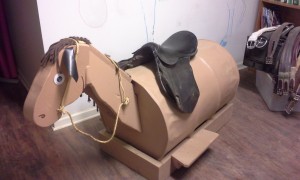

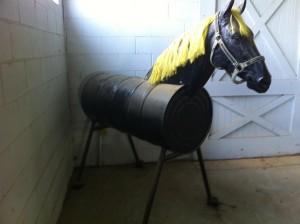

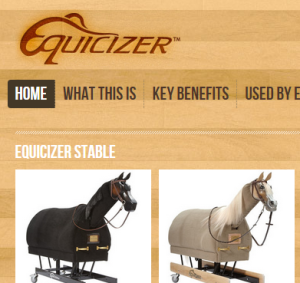
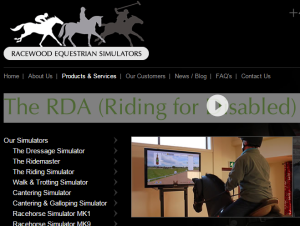
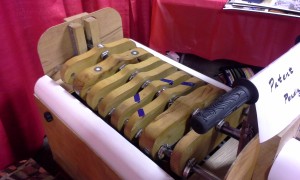
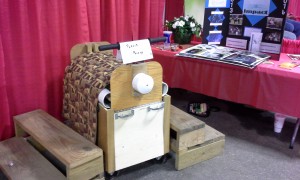
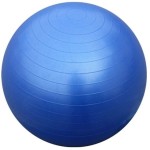
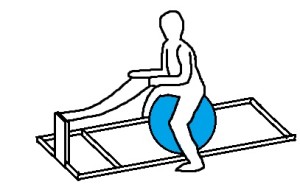
Thanks for sharing this information. I found it very informative as I have been researching a lot lately on practical matters such as you talk about.
Awesome information… I have just acquired a barrel horse (use to be used for vaulting) named Tin Tin. Great ideas… thank you.💕🐴👍😊